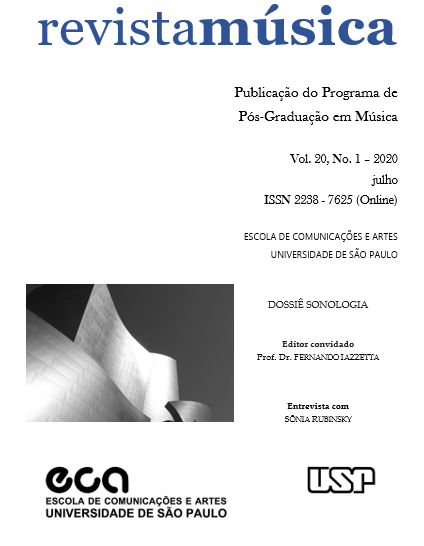Headphone Listening Cultures
Contingencies and Crossings
DOI:
https://doi.org/10.11606/rm.v20i1.172212Palabras clave:
Audio Culture, Headphones, Walkman, Audio PortabilityResumen
This paper discusses the headphones as key factors in the establishment of a mobile listening culture by suggesting that the function of this artifact has been changing according not only with technological innovation, but also with economic contingencies borrowed from capitalist logics. By discussing concepts such as tympanic function (Jonathan Sterne) and Commodity Scientism (Thimoty Taylor) the text will examine theories on the origins of headphones, as well as analyzing early models. The Walkman, launched in the 1980, will be the subject of a detailed scrutiny, since it is responsible for linking the use of audio devices with the urban life. Afterward, the article will confront a handful of texts discussing mobile listening, fostered by the Walkman and extended by subsequent portable audio products such as the Apple’s iPod. In the contemporaneity, the headphones underwent a process of stylization and have achieved the status of a fashion accessory. On the other hand, they are being implemented in interactive audio narratives such as games and smartphone applications. Locative audio will be discussed as an experimental field envisaging future functions and features for the headphones.
Descargas
Referencias
ACOSTA MAYA, S. The Sony Walkman. Revista Universidad EAFIT, v. 36, n. 117, p. 19-27, jun. 2012.
APPLE. iTunes Store Top Music Retailer in the US. Apple, 2008. Retrieved from: <https://www.apple.com/newsroom/2008/04/03iTunes-Store-Top-Music-Retailer-in-the-US>. Accessed on: May 2020.
BEHRENDT. F. Locative media as sonic interaction design: walking through placed sounds. Journal of Mobile Media, v. 9, n. 2, 2015. Retrieved from <http://wi.mobilities.ca/frauke-behrendt-locative-media-as-sonic-interaction-design-walking-through-placed-sounds>. Accessed on: May 2020.
BEYERDYNAMIC. Once and Today. Beyerdynamic, 2014. Retrieved from: <https://global.beyerdynamic.com/company/once-and-today>. Accessed on: May 2020.
BULL, M. Sounding Out the City: Personal Stereos and the Management of Everyday Life. Oxford: Berg, 2000.
BULL, M. No Dead Air! The iPod and the Culture of Mobile Listening. Leisure Studies, v. 24, n. 4, p. 343-355, 2005.
CHAMBERS, I. The Aural Walk. In: COX, C.; WARNER, D. (ed.). Audio Culture: readings in modern music. New York: Continuum, 2004.
CUMMINGS, A. S. Democracy of Sound: music piracy and the remaking of american copyright in the twentieth century. New York: Oxford University Press, 2013.
DU GAY, P. et al. Doing Cultural Studies: the story of the Sony Walkman. London: SAGE Publications, 1997.
ESTREICH, B. The Electrophone System. Bob’s Old Phones, 2013. Retrieved from: <https://www.telephonecollecting.org/Bobs%20phones/Pages/Essays/Electrophone.htm>. Accessed on: May 2020.
GREENBURG, Z. Dr. Dre’s $3 Billion Monster: The Secret History Of Beats. Forbes, 2013. Retrieved from: <https://www.forbes.com/sites/zackomalleygreenburg/2018/03/08/dr-dres-3-billion-monster-the-secret-history-of-beats-3-kings-book-excerpt/#478d996e258d>. Accessed on: May 2020.
HILL, B. The iTunes influence. Engadget, 2013. Retrieved from: <https://www.engadget.com/2013/04/29/the-itunes-influence-part-one, https://www.engadget.com/2013/04/30/the-itunes-influence-part-two-setting-the-music-free, and https://www.engadget.com/2013/05/01/itunes-influence-art-in-the-age-of-digital>. Accessed on: May 2020.
HOSOKAWA, S. The Walkman effect. 1984 [2012]. In: STERNE, J. (ed.). The Sound Studies Reader. New York: Routledge, 2012.
HOWETH, L. S. History of Communications: electronics in the United States Navy. Washington, D.C.: U.S. Government Printing Office, 1963.
IAZZETTA, F. Música e Mediação Tecnológica. São Paulo: Perspectivas, 2009.
ISAACSON, W. Steve Jobs. New York: Simon & Schuster, 2011.
KOSS. Koss history. Koss, 2015. Retrieved from <https://www.koss.com/history>. Accessed on: May 2020.
SINGER, M. Nathaniel Baldwin, Utah Inventor and Patron of the Fundamentalist Movement. Utah Historical Quarterly, v. 47, n. 1, p. 42-53, 1979.
STERNE, J. The Audible Past: cultural origins of sound reproduction. Durham; London: Duke University Press, 2003.
STERNE, J. Mp3: the meaning of a format. Durham; London: Duke University Press, 2012.
TAYLOR, T. Strange Sounds. New York: Routledge, 2001.
TOWNSEND, A. Locative-Media Artists in the Contested-Aware City. Leonardo, v. 39, n. 4, p. 345-347, 2006.
HUNT, A.; HERMANN, T. Interactive Sonification. In HERMAN, T., HUNT, A., NEUHOFF, H. (ed.), The Sonification Handbook. Berlin: Logos-Verlag, 2011.
TUTERS, M.; VARNELIS, K. Beyond Locative Media: Giving Shape to the Internet of Things. Leonardo, v. 39, n. 4, p. 357-363, 2006.
VERSTRAETE, P. The Secret Theater revisited: eavesdropping on Locative Media Performance. Journal of Sonic Studies, v. 15, n. 1, 2017. Retrieved from <https://www.researchcatalogue.net/view/411830/411831>. Accessed on: May 2020.
Descargas
Publicado
Número
Sección
Licencia
Derechos de autor 2020 Julián Jaramillo Arango, Paulo Assis Barbosa, Esteban Astorga

Esta obra está bajo una licencia internacional Creative Commons Atribución-NoComercial-CompartirIgual 4.0.
Autores que publicam nesta revista concordam com os seguintes termos:
- Autores mantém os direitos autorais e concedem à revista o direito de primeira publicação, com o trabalho simultaneamente licenciado sob a CC Attribution-NonCommercial-ShareAlike 4.0 que permite o compartilhamento do trabalho com reconhecimento da autoria e publicação inicial nesta revista.
- Autores têm autorização para assumir contratos adicionais separadamente, para distribuição não-exclusiva da versão do trabalho publicada nesta revista (ex.: publicar em repositório institucional ou como capítulo de livro), com reconhecimento de autoria e publicação inicial nesta revista.
- Autores têm permissão e são estimulados a publicar e distribuir seu trabalho online (ex.: em repositórios institucionais ou na sua página pessoal) a qualquer ponto antes ou durante o processo editorial, já que isso pode gerar alterações produtivas, bem como aumentar o impacto e a citação do trabalho publicado (Veja O Efeito do Acesso Livre).
Cómo citar
Datos de los fondos
-
Coordenação de Aperfeiçoamento de Pessoal de Nível Superior
Números de la subvención Finance Code 001


